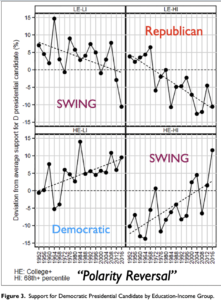Why “Medicare for All” Could Appeal to White Swing Voters.
Posted on | July 12, 2022 | Comments Off on Why “Medicare for All” Could Appeal to White Swing Voters.
Mike Magee
“There’s common ground there—not the warm belonging of full creedal agreement, perhaps, but a place, even a welcoming place, where we can stand together.” Ian Marcus Corbin, Research Fellow, Harvard Medical School
Most Americans would love to believe this statement. But political reality intervenes. A March, 2022 Pew Research Center analysis found our two major parties to be “farther apart ideologically today than at any time in the past 50 years.”
Take, for example, Presidential hopefuls, Florida Gov. Ron DeSantis and Sen. Marco Rubio (R-Fla.). They see political pay dirt on the jagged peaks of America’s culture wars with the governor taking on Disney for defending LGBTQ employees by introducing the his “Stop W.O.K.E. Act“, while Rubio goes one step further with his “No Tax Breaks for Radical Corporate Activism Act”.
In academic circles, you increasingly find references to “what’s the matter with…debates.” The phrase derives from a 2004 book “What’s the Matter with Kansas?” written by historian Thomas Frank, which spent 18 weeks on the New York Times Bestseller List.
In the book, Frank detailed the transformation of Kansas from a “hotbed of left-wing populism” to a center of “anti-elitist conservatism in the United States” and exposed the state’s remarkable capacity to vote against its own economic self-interests.
The title itself originated in an August 15, 1896 editorial in the the Kansas Emporia Gazette. It was written by a political leader, William Allen White, who charged that the state’s slippage into economic stagnation (compared to neighboring states) was the result of overly aggressive progressive policies which unduly restricted small business. William McKinley, in his 1896 run for the Presidency, picked up on the theme, distributing hundreds of thousands of copies of the editorial as part of his campaign.
In modern times, selected academics argue that working-class social conservatives have abandoned the Democratic New Deal political coalition and landed on the rocky knolls of Republican shores mired in conservative ideology and buffeted by religion laced cultural gale-force winds.
Others, like Vanderbilt political scientist Larry Bartels, challenged these assumptions. As he summarized in 2005: “Has the white working class abandoned the Democratic Party? No. White voters in the bottom third of the income distribution have actually become more reliably Democratic in presidential elections over the past half-century, while middle- and upper-income white voters have trended Republican.”
A recent publication by two political scientists – Herbert P. Kitschelt from Duke and Philipp Rehm from Ohio State – says no one should be surprised by what happened in 2016, because it was a long time in the making.
What makes white Americans vote the way they do, they say, lies at the cross-roads of economics and education. Using a four quadrant analysis graph, they tracked white voters presidential preferences from 1952 to 2016 in four groups – I. Low Education/Low Income, II. Low Education/High Income, III. High Education/Low Income, IV. High Education/High Income.

Using a version of this graph, they concluded that that there has been a “polarity reversal…the New Deal core constituencies of the two main US parties—low-education/low-income voters for the Democrats and high-education/high-income voters for the Republicans—have become swing groups; the former swing groups are the parties’ new core constituencies (high-education/low-income voters for the Democrats and low-education/high-income voters for the Republicans).”
Specifically they believe that:
- The Democratic Party is being abandoned by lower education/higher income white voters. (Think small business men/local Chambers of Commerce), while higher education/higher income are slowly moving to neutral “swing” status.
- Lower income workers are also segregating based on education. Those white voters with little income or education are moving away from Democrats to neutrality – “drifting into right-wing politics” and exploring militarizing “social governance, racism and xenophobia.” In contrast, low income, high education whites are securely now in Democratic territory.
What does all this mean? It appears that, as we have transformed from an industrial society to a knowledge society, the traditional New Deal core groups (Dem- LE/LI; Rep- HE/HI) that anchored the two parties have become swing groups filled with divided, volatile “independents” up for grabs.
How do you reach these new swing voters? Is there anything programmatic that might enjoy the support of large numbers of swing voters?
How about those Big Education/High Income individuals. In 2020, 68% of the S&P 1500 CEO’s were Republicans in a National Bureau of Economic Research study. What might the government offer the workers that labor in their charge?
How about those Low Education/Low Income individuals. Many manage to rise to intermediate incomes, only to fall back when faced with predatory debt often associated with a family illness or tragedy.
Programmatic solutions that would unite us need to appeal on multiple levels to members of swing quadrants. One concrete example would be “Medicare for All.” It would free the HE/HI CEO’s of managing employee health care while trying to run their companies. It would also assist LE/LI strivers by reinforcing health and productivity, avoiding crippling medical debt, and creating new job opportunities.
So, in fact, as Dr. Corbin suggests, “There’s common ground…a welcoming place, where we can stand together.” Programs and services that create jobs, reinforce community linkages, and equitably promote compassion, understanding and opportunity are political pay dirt. Democrats and Republicans would help themselves, and help America, by seeking “common ground” under the banner of “Medicare-for-All.”


